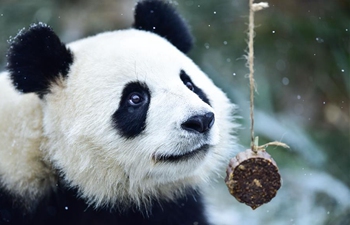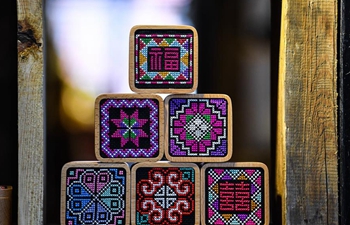by Burak Akinci, Wang Feng
VAN, Turkey, Nov. 30 (Xinhua) -- The Turkish Van is a kind of silky cat with a white body from Turkey's eastern Lake Van region. Unlike other feline species, it has a liking for swimming thanks to its water-proof coat, a unique feature.
With a plumed tail, the cat wears silky fur, which turns thick and dense in the winter and shorter in the summer, and is easy to groom.
The cat is not only loved in Van where it's a mark of the region and the lake, but across the whole country where it is a source of national pride.
When the number of purebred felines dwindled in the modern ages, in order to expand the cat's bloodline, the Turkish government officially recognized the Van cat and launched measures to protect it, while a local university has developed breeding programs.
Today, it is strictly prohibited to export the breed abroad and transgressors are met with a high penalty and criminal charges.
The Turkish Van cats, who are known for their eyes and fluffy white hair with color around the head area and the tail, are the lucky feline species in the country as they have the opportunity to swim in pools specifically designed for their needs by the authorities.
The Turkish Van Cat Research Center, which comes under the Yuzuncu Yil University in Van province, is behind the project of producing purebreds since its foundation in 1992.
Head of the Turkish Van Cats Center, Abdullah Kaya, a professor in veterinary science, told Xinhua that the pools had been installed in the center to train the cats when they are kittens to fulfill their innate need for swimming.
"A cat aficionado to whom we have given a cat in Izmir (in western Turkey) told me that his Van cat loved swimming and taking baths when they are making trips on his boat," said the specialist.
It's unknown why Van cats like water, but it's likely that the breed developed its love for swimming and its water-proof coat to hunt the fish that live in Lake Van.
The Turkish Van cats can be categorized according to the color of their eyes and furs. Some are odd-eyed -- one blue and the other amber, and others have a pair of blue or amber eyes.
Also, while some have completely white fur, others have a dash of brown above their ears or on their body.
The male and female Turkish Van cats at the research center are being kept in separate enclosures so that researchers could control their breeding and carry out specific studies, explained Kaya.
The cat breed is also said to be one of the biggest cultural heritage of the province. In the old days, everyone had a house and a small garden, an ideal environment for the cats; however, this way of living has disappeared over the years with apartment blocks and people have been reluctant to own a cat.
"In order to increase the number of the cats which were approaching an extinction, we are working here on reproduction of purebreds," insisted Kaya.
It's believed that the furry cat has lived in Turkey's isolated Lake Van region, a mountainous area home to the country's largest lake for many generations, thanks to local legends, traditional folk songs, and ancient artifacts that recorded the cat and its unusual markings.
Documentation shows that the cat didn't make its mark on the world until the mid 1950s.
Abdullah Kaya pointed out that the Turkish Van cat, different from the Ankara or Angora cats from central Anatolia and modern-day Turkish capital, is a friendly and lively feline and not a cuddly lap cat.
"They are very intelligent and have a remarkable high capacity for learning and to connect emotionally with their owners with whom they share a deep bond," he added.
The Turkish Van cat needs exactly the same type of responsibility as any other cat, and a lot of tender and gentle care form it's lucky owner.
(Umut Ozlu in Ankara also contributed to the story.)

















